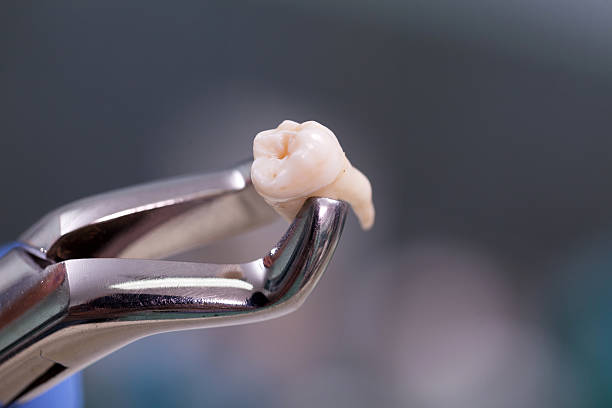
Definition of Tooth Extractions
A tooth extraction is a dental procedure that involves removing a tooth from its socket in the jawbone. Tooth extractions are performed for various reasons, including decay, crowding or misalignment of teeth, infection or abscessed teeth, impacted wisdom teeth/third molars, and preparing for orthodontic treatment/braces or braces dentures and other prosthetic devices.
Various Tooth Extractions
There are various types of tooth extractions: simple and surgical. Simple extractions for once involve removing teeth that can be seen above the gums. On the other hand, surgical extractions require more intensive procedures to remove teeth that cannot be seen above the gums, such as impacted or abscessed teeth.
Overview of the Procedure
Before any extraction, a dentist will evaluate the patient and take X-rays to determine which type of extraction is necessary. Depending on the type of extraction performed, a local anesthetic may be used to minimize pain and discomfort during the procedure. Afterward, patients may experience some swelling and discomfort in the area where the tooth was removed for a few days after.
Reasons for Getting a Tooth Extraction
A. Decay and Damage
Tooth decay can cause damage to a tooth that makes it impossible to restore with fillings or other dental treatments. In these cases, tooth extraction might be the only option to prevent further damage.
B. Crowded Teeth or Malocclusion
If teeth are crowded or misaligned, tooth extraction may be recommended by a dentist to create space for orthodontic treatment/braces.
C. Infection or Abscesses
An infection in the root of a tooth can cause an abscess and require an immediate extraction to prevent further damage and the spread of the infection.
D. Impacted Wisdom Teeth/Third Molars
These molars grow at awkward angles, either sideways or backward, making them more difficult to clean and maintain proper oral hygiene around them. In these cases, it’s often best to extract the wisdom teeth to prevent further damage.
E. Before Orthodontic Treatment/Braces
Sometimes, tooth extraction may be recommended before orthodontic treatment/braces are started to create more space in the mouth for the teeth that need to be moved during the treatment.
F. Preparing for Dentures or Other Prosthetic Devices
Depending on the patient’s mouth structure, some teeth may need to be extracted before dentures or other prosthetic devices can be fitted properly.
Different Types of Extractions Performed by a Dentist
A. Simple Tooth Extractions
A Dental Procedure to Remove Teeth that are Visible Above the Gums: A simple extraction is a procedure that is used to remove a tooth that can be seen above the gums. During the procedure, a dentist will use special tools to loosen and extract the tooth from its socket in the jawbone.
B. Surgical Tooth Extractions
A Dental Procedure to Remove Teeth that are not Visible Above the Gum Line: A more intensive surgical extraction is necessary when teeth cannot be seen above the gum line. This type of extraction involves making an incision in the gum tissue to expose the underlying root of the tooth before it can be removed.
Differences Between a Simple and a Surgical Extraction
A. The Procedure Itself
As mentioned previously, simple extractions involve removing teeth visible above the gums. In contrast, a surgical extraction requires an incision in the gum tissue to expose and remove teeth not visible above the gums.
B. When Each Type of Extraction is Used
Simple extractions are typically used for teeth that can be seen above the gums, while surgical extractions are typically used for impacted wisdom teeth/third molars, abscessed teeth, or any other tooth that needs to be removed from beneath the gum line.
What to Expect During Tooth Extractions?
A. Local Anesthetic for Pain Management
Before any tooth extraction procedure, a local anesthetic will be administered to minimize any pain or discomfort during the procedure.
B. Discomfort or Swelling After the Procedure
After any tooth extraction procedure, patients may experience discomfort and swell in the area where the tooth was removed. This should subside within a few days.
C. Care Following Your Tooth Extractions
Following any tooth extraction procedure, it is important to follow your dentist’s instructions for proper care, such as avoiding straws and using an antibacterial rinse to promote healing and prevent infection.
Conclusion
Understanding the basics of tooth extractions and the processes and procedures involved can be quite helpful. If you are considering a tooth extraction, speaking with a highly-skilled dentist in West Covina for assistance and advice is important. Our dental practice has state-of-the-art equipment and experienced professionals who provide fast and safe dental treatment.
We understand that some people feel anxious or scared of getting a tooth extraction, but our team will do their best to discuss all the details of your treatment plan to ease any discomfort. Remember, when it comes down to it, many people need a tooth extraction, so don’t fret too much – get informed and stay up-to-date on the latest developments in dentistry research. Know that you’re in good hands at our dental practice, and contact us now for further assistance!

